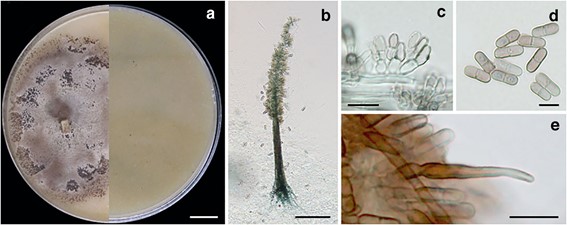Synnematotriadelphia stilboidea (Mercado & R.F. Castañeda) Chuaseehar., Somrith., Nuankaew & Boonyuen, comb. nov. Fig. 3
MycoBank number: MB 833281; Index Fungorum number: IF 833281; Facesoffungi number: FoF;
Basionym: Triadelphia stilboidea Mercado & R.F. Castañeda, Revista Jard. Bot. Nac., Univ. Habana 4: 68. 1983 [MB107669].
Asexual morph: Colonies effuse, hairy, grey, or brown. Mycelium partly superficial, hyphae 2.2–4 μm wide. Conidiomata synnematous, simple, solitary, 150–750 μm height, 20–40 μm wide at the base, 35–70 μm wide at the middle, 5–9 μm wide at the apex, brown; parallel hyphae of synnemata 2.2–3.5 μm wide. Conidiogenous cells holoblastic, monoblastic, fasciculate, spherical, subspherical, ellipsoidal or cylindrical, olivaceous or olivaceous brown, 2.5–6× 2– 3.5 μm. Conidia pleomorphic, produced in two different forms on synnemata: predominating cylindrical, ellipsoidal or obclavate conidia (0–)1-septate, 7.5–15 × 2.4–4.7 μm (as conidial type a in Triadelphia) and obclavate conidia with rostrum, 0-septate, brown at the base, paler toward the subhyaline apex, 20–85 μm long, 3.5–4.7 μm wide at the base, 0.7–1 μm wide at the rostrum (as conidial type c in Triadelphia). Colonies of CBS 221.85 in synthetic media developing synnemata or hairy-like structures. Vegetative mycelium septate, subhyaline, or olivaceous. Synnemata in older cultures blackish brown. Conidiophores erect, smooth, brown. Conidiogenous cells fasciculate, smooth-walled, olivaceous, or subhyaline. Conidia pleomorphic, produced in two different forms on synnemata as on natural substratum. However, obclavate conidia could be found. On MEA reverse black. Vegetative mycelium 1.5–2 μm wide. Conidiophores 350–600 × 2–3 μm. Conidiogenous cells 3–6× 2–2.5. Cylindrical or ellipsoidal conidia 7–11 × 3–4.5 μm; obclavate conidia with rostrum 20– 50 μm long, 3–4 μm wide at the base (Mercado and Castañeda 1983). On OA reverse yellowish white. Vegetative mycelium 1–1.5 μm wide. Conidiophores 230–300 μm high, 12.5–20 μm wide at the base, 6.25–12.5 μm wide at the middle, 3.75–5 μm wide at the apex μm, composed of sterile part at the base and 65–70% of the total synnema height fertile part at the apex; parallel hyphae of synnemata, 1.5–2 μm wide with terminal short branches (3–5× 2–3 μm) bearing 1–4 conidiogenous cells. Conidiogenous cells 4–5× 1.7–2.5 μm. Cylindrical or ellipsoidal conidia 7.5–10 × 2.4–3.75 μm; obclavate conidia with rostrum 22.5–42.5 × 2.5–3.75 μm (this study).Sexual morph: undetermined.
Holotype: Cuba, Havana, Botanical garden, on dead leaf petiole of Roystonea regia (Kunth) O.F.Cook, 20 Apr 1982, A. Mercado, No. 6865 (holotype); ex-holotype living culture, CBS 221.85.

Fig. 3 Synnematotriadelphia stilboidea (CBS 221.85, ex-holotype): (a) colony surface (left) and colony reverse (right) on OA after 60 days; (b) synnematous conidioma; (c) conidiogenous cells; (d) conidia; (e) proliferating conidiogenous cell. Scale bars: a = 1 cm, b = 50 μm, c, d = 5 μm, e = 10 μm
